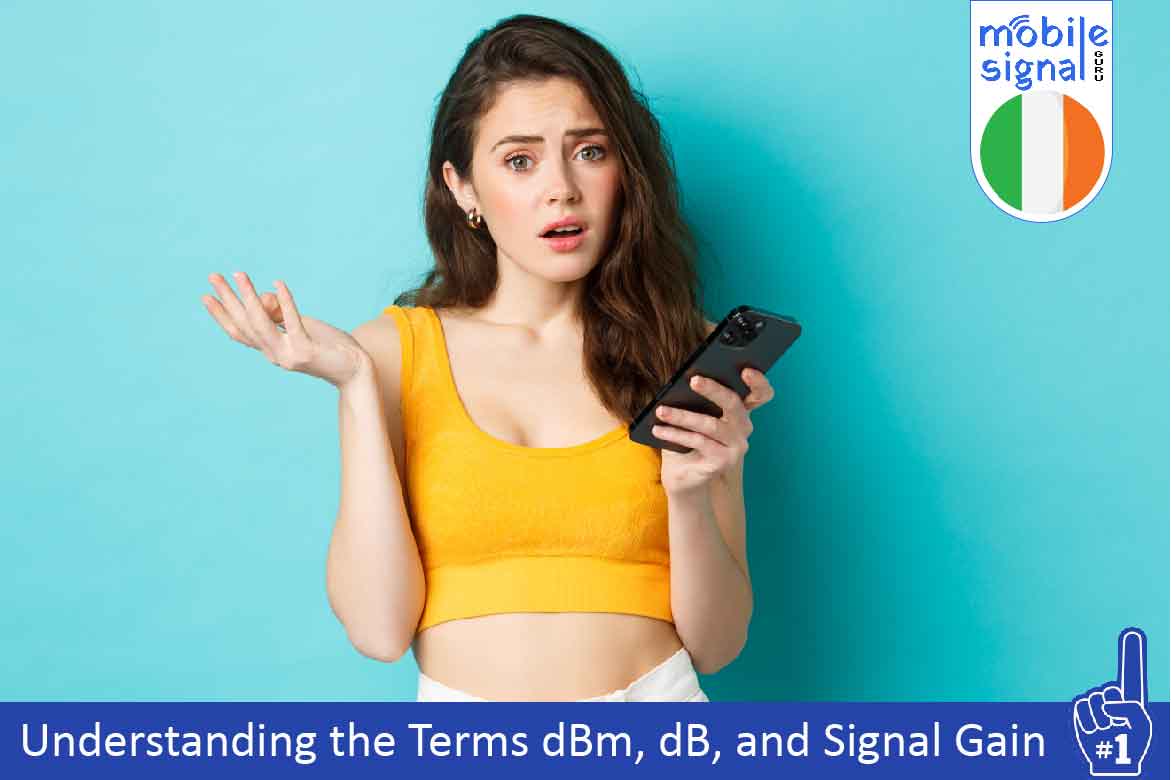Mobile signal strength can often seem confusing. But learning a few key terms can make a big difference. In this detailed guide, we will explore the meanings of dBm, dB, and signal gain. These are crucial when trying to improve mobile signal strength across Ireland. Whether you live in a busy city, a small village, or the open countryside, this guide will help you.
We will keep the language very simple and easy to follow. No complex terms or technical jargon. Just clear, useful information to help you understand how mobile signal boosters work. Let’s begin.
What is dBm?
dBm stands for decibel-milliwatts. It is a unit used to measure signal strength. Every mobile phone receives signals that are measured in dBm. This number is almost always negative. The closer the number is to zero, the stronger the signal.
Here are some examples of dBm values:
- −50 dBm = excellent signal
- −70 dBm = good signal
- −90 dBm = poor signal
- ∓110 dBm = no usable signal
If your phone often shows one or two bars, your dBm reading is probably below -100. That is a weak signal. Knowing your dBm value helps you understand how strong your signal is. This also helps you choose the right mobile signal booster.
What is dB?
dB stands for decibel. It does not measure absolute strength like dBm. Instead, it measures the change in signal power. You can think of dB as showing how much a signal has increased or decreased.
Some examples:
- +10 dB means the signal is 10 times stronger
- +20 dB means the signal is 100 times stronger
- -10 dB means the signal is 10 times weaker
dB is useful when talking about the performance of antennas, cables, and boosters. For instance, if a cable causes a loss of 3 dB, your signal becomes weaker. If a booster adds 20 dB gain, it increases the signal strength significantly.
What is Signal Gain?
Signal gain is how much a signal is improved. It is measured in dB. Mobile signal boosters use signal gain to improve weak signals. The higher the gain, the better the signal becomes.
Here’s an example: If a weak signal at -100 dBm is boosted by 30 dB, the new signal becomes -70 dBm. That’s a huge improvement. You can now make clear calls and enjoy fast internet.
Signal gain is especially important in rural areas. In Ireland, many places are surrounded by hills, trees, or old buildings. These block mobile signals. High-gain boosters can help overcome those problems.
How Mobile Signal Boosters Use These Terms
When you shop for a mobile signal booster in Ireland, you will see terms like dBm and dB. It’s important to understand what they mean:
- Input signal (dBm): This is the signal that the outdoor antenna receives from the tower
- Gain (dB): This is how much the booster improves the signal
- Output signal (dBm): This is the improved signal your phone receives inside your home
Example setup:
- Input signal: -100 dBm (very weak)
- Gain: 60 dB
- Output signal: -40 dBm (strong signal)
This level of improvement can change your mobile experience completely. Calls will stop dropping. Websites will load quickly. Videos will stream without buffering.
Why Signal Strength Matters
Strong signal equals better performance. Here’s what a weak signal can cause:
- Calls that drop suddenly
- Poor voice quality
- Slow mobile internet
- Apps not working properly
- Delayed text messages
Here’s what a strong signal provides:
- Clear voice calls
- Quick downloads and uploads
- Fast browsing speeds
- Smooth video calls and streaming
- Reliable message delivery
Measuring your signal strength using dBm helps you understand your problem. It makes it easier to choose a suitable booster.
How to Check Your dBm Level
You can find your current signal strength using your phone. Here’s how:
For Android phones:
- Go to “Settings”
- Tap “About Phone”
- Select “Status” or “SIM Status”
- Find “Signal Strength”
For iPhones:
- Open the Phone app
- Dial 3001#12345#
- Press the call button
- Tap “Serving Cell Meas”
- Look for “RSRP” (similar to dBm)
The signal strength is usually a negative number. Remember, the closer to zero it is, the stronger the signal. A value between -50 and -80 dBm is generally good.
What Affects Mobile Signal Strength in Ireland?
In Ireland, mobile signal strength varies a lot. Many factors affect it:
- Distance from mobile towers
- Hills and high terrain
- Thick stone walls in older homes
- Dense forests and tree cover
- Heavy rain or bad weather
- Other buildings and metal roofs
Ireland has many remote areas and old buildings with thick stone walls. These are beautiful but often block signals. Signal boosters help improve connectivity in such places.
Choosing the Right Mobile Signal Booster
Not all boosters are the same. Picking the right one is important. Here are things to consider:
- Frequency bands: Check which bands your mobile network uses
- Gain: Higher gain is better for rural or remote areas
- Coverage area: Choose a booster that covers the size of your house or office
- Antenna type:
- Directional antennas focus on one direction, ideal for rural homes
- Omnidirectional antennas cover all directions, better for cities
Ask yourself: Where do you live? What is your current signal strength? How large is the area you want to cover? These questions help you choose wisely.
Installation Tips for Best Performance
A mobile signal booster needs proper setup. Follow these tips:
- Mount the outdoor antenna as high as possible (roof is best)
- Point it toward the nearest cell tower
- Avoid obstacles between the antenna and the tower
- Keep at least 10 meters between indoor and outdoor antennas
- Use good-quality cables to reduce signal loss
- Place the indoor antenna in a central area
Correct installation ensures your booster gives you the best signal possible. If installed poorly, you won’t get the full benefit.
Benefits of Using a Mobile Signal Booster
Using a mobile signal booster in Ireland offers many advantages:
- No more dropped calls
- Clear voice quality
- Fast 4G and 5G data speeds
- Smooth video calls with no freezing
- Better battery life on your phone
- Strong signal in every room
Boosters work with all major networks in Ireland. This includes Vodafone, Three, Eir, and others. Whether you use one phone or many, boosters improve the experience for everyone.
Are Mobile Signal Boosters Legal in Ireland?
Yes, mobile signal boosters are legal in Ireland. But only if they are approved by ComReg (the communications regulator). Legal boosters must also have CE certification. This ensures they meet safety and quality standards.
Never buy cheap or unapproved devices. These can cause signal interference and are illegal. They can even block your neighbour’s signal.
Mobile Signal Guru only sells ComReg-approved and CE-certified boosters. You can trust them for safe, legal, and reliable solutions.
Conclusion: Improve Your Signal with Mobile Signal Guru
Now you understand what dBm, dB, and signal gain mean. These terms help you choose the best mobile signal booster. In Ireland, signal problems are common, especially in rural and stone-built homes. A good signal booster makes a big difference.
If you suffer from dropped calls, slow data, or weak coverage, don’t wait. A mobile signal booster will solve those issues. Check your dBm, calculate the gain you need, and pick the right device.
Mobile Signal Guru offers expert advice and top-quality boosters. We help people across Ireland stay connected. All of our products are tested, legal, and reliable.
Take control of your mobile signal today. Buy your booster from Mobile Signal Guru. Stay connected, wherever you are in Ireland! If you have any questions regarding any of our products please contact us.
 Australia (AUD)
Australia (AUD) Denmark (DKK)
Denmark (DKK) France (EUR)
France (EUR) Germany (EUR)
Germany (EUR) Italy (EUR)
Italy (EUR) Malta (EUR)
Malta (EUR) Netherlands (EUR)
Netherlands (EUR) New Zealand (NZD)
New Zealand (NZD) Norway (NOK)
Norway (NOK) Spain (EUR)
Spain (EUR) Sweden (SEK)
Sweden (SEK) UAE (AED)
UAE (AED) United Kingdom (GBP)
United Kingdom (GBP) Global Site (USD)
Global Site (USD)
